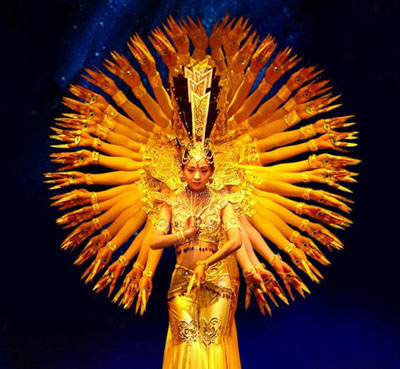 |
|
China Disabled People's Performing Arts Troupe perform Thousand Hands Guanyin, directed by Zhang Jigang, in Spain in January 2007. [File photo]
|
With explosive fireworks, thundering drumbeats and spectacular dancing, the opening ceremony of the Beijing Olympic Games successfully condensed thousands of years of Chinese history into hours and left a lasting impression in the minds of people around the world.
The event added another wonderful page to the life of Zhang Yimou, General Director of the Olympic opening and closing ceremonies. In his shadow was Deputy Director Zhang Jigang, who was later given his own stage to shine on-the Paralympic ceremonies.
Zhang was charge of the opening and closing ceremonies for the Paralympics. Speaking ahead of the opening ceremony on September 6, he said the opening ceremony would portray human beings' understanding of life and the universe, while the closing ceremony on September 17 would be highly interactive. Both shows include touching details and would rival the opening of the Olympic Games, he added.
"Life will be interpreted through three elements-the sky, the earth and the people," Zhang said. These three elements are also reflected in the emblem of the Beijing Paralympics.
One of the highlights of the opening ceremony was a sign-language dance entitled Greetings to Stars, performed by hundreds of girls with hearing- or speech-impairments.
Zhang's most famous work-Thousand Hands Guanyin (goddess of mercy)-was performed by 21 hearing-impaired dancers. The girls stood in a column, with the lead girl, playing the Guanyin, facing the audience and the other girls behind playing her many arms.
The girls' movements had to be perfectly timed and accurately positioned to produce the desired effect of a Buddha with thousands of hands. The challenging part was that the girls could not dance to the rhythm of the music, because they couldn't hear it. A behind-the-scenes conductor directed the performance using sign language. The girls needed to feel the rhythm and express the beauty and kindness of the Buddha with their hands and most importantly their hearts, Zhang said.
Zhang worked through sign-language teachers during rehearsals. "Through the sign-language teachers, I could explain the emotions in the music to the dancers so that the expressions on their faces matched the music," Zhang said. "I also had to tell the girls when and how to breathe between their movements."